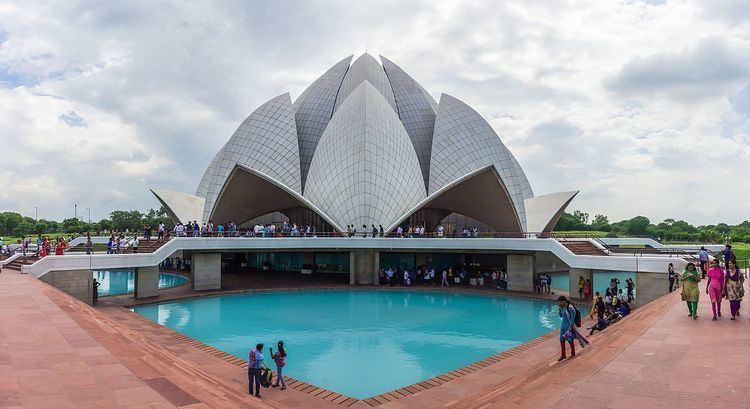Type House of Worship Completed 13 November 1986 Structural engineer Flint & Neill Opened 13 November 1986 | Diameter 70 metres (230 ft) Height 34 m | |
 | ||
Structural system Concrete frame and precast concrete ribbed roof Address Similar Qutb Minar, India Gate, The Red Fort, Humayun's Tomb, Akshardham | ||
Lotus temple new delhi
The Lotus Temple, located in Delhi, India, is a Bahá'í House of Worship completed in 1986. Notable for its flowerlike shape, it serves as the Mother Temple of the Indian subcontinent and has become a prominent attraction in the city. Like all Bahá'í Houses of Worship, the Lotus Temple is open to all, regardless of religion or any other qualification. The building is composed of 27 free-standing marble-clad "petals" arranged in clusters of three to form nine sides, with nine doors opening onto a central hall with height of slightly over 40 metres and a capacity of 2,500 people. The Lotus Temple has won numerous architectural awards and been featured in hundreds of newspaper and magazine articles. A 2001 CNN report referred to it as the most visited building in the world.
Contents
- Lotus temple new delhi
- Worship
- Structure
- Tourism
- Distinctions
- Awards
- Articles
- Books
- Television
- Stamps
- Music
- Most visitors
- Government representatives
- Others
- Lists
- References
Worship
The Bahá'í Faith teaches that a Bahá'í House of Worship should be a space for people of all religions to gather, reflect, and worship. Anyone may enter the Lotus Temple irrespective of religious background, sex, or other distinctions, as is the case with all Bahá'í Houses of Worship. The sacred writings of not only the Bahá'í Faith but also other religions can be read and/or chanted, regardless of language; on the other hand, reading non-scriptural texts is forbidden, as are delivering sermons or lectures and fundraising. Musical renditions of readings and prayers can be sung by choirs but no musical instruments can be played inside. There is no set pattern for worship services, and ritualistic ceremonies are not permitted.
Structure
All Bahá'í Houses of Worship, including the Lotus Temple, share certain architectural elements, some of which are specified by Bahá'í scripture. `Abdu'l-Bahá, the son of the founder of the religion, stipulated that an essential architectural character of a House of Worship is a nine sided circular shape. While all current Bahá'í Houses of Worship have a dome, this is not regarded as an essential part of their architecture. Bahá'í scripture also states that no pictures, statues or images be displayed within the House of Worship and no pulpits or altars be incorporated as an architectural feature (readers may stand behind simple portable lecture stands).
Inspired by the lotus flower, the design for the House of Worship in New Delhi is composed of 27 free-standing marble-clad "petals" arranged in clusters of three to form nine sides. The nine doors of the Lotus Temple open onto a central hall slightly more than 40 metres tall that can seat 1,300 people and hold up to 2,500 in all. The surface of the House of Worship is made of white marble from Penteli mountain in Greece, the same marble from which many ancient monuments (including the Parthenon) and other Bahá'í Houses of Worship are built. Along with its nine surrounding ponds and the gardens, the Lotus Temple property comprises 26 acres (105,000 m²; 10.5 ha).
The temple is in the village of Bahapur in New Delhi, National Capital Territory of Delhi. The architect was an Iranian, who now lives in Canada, named Fariborz Sahba. He was approached in 1976 to design it and later oversaw its construction. The structural design was undertaken by the UK firm Flint and Neill over the course of 18 months, and the construction was done by ECC Construction Group of Larsen & Toubro Limited. The major part of the funds needed to buy this land was donated by Ardishír Rustampúr of Hyderabad, Sindh, who gave his entire life savings for this purpose in 1953. A portion of the construction budget was saved and used to build a greenhouse to study indigenous plants and flowers that would be appropriate for use on the site.
Of the temple's total electricity use of 500 kilowatts (KW), 120KW is provided by solar power generated by the building. This saves the temple 120,000 rupees per month. It is the first temple in Delhi to use solar power.
Tourism
The Bahá'í House of Worship in Delhi was inaugurated to public worship in December 1986. By late 2001, it had attracted more than 70 million visitors, making it one of the most visited buildings in the world. According to the government of India, it had received over 100 million visitors by April 2014.
Distinctions
The Temple has received wide range of attention in professional architectural, fine art, religious, governmental, and other venues.
Awards
Articles
By 2003, the Baha'i World Centre Library had archived more than 500 publications which have carried information on the Lotus Temple in the form of articles, interviews with the architect and write-ups extolling the structure. The following are major examples of publications featuring articles on the temple listed chronlogically, and excerpted quotations:
Books
Television
By 2003, the temple had been featured in television programmes in India, Russia, and China.
